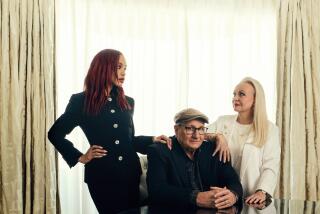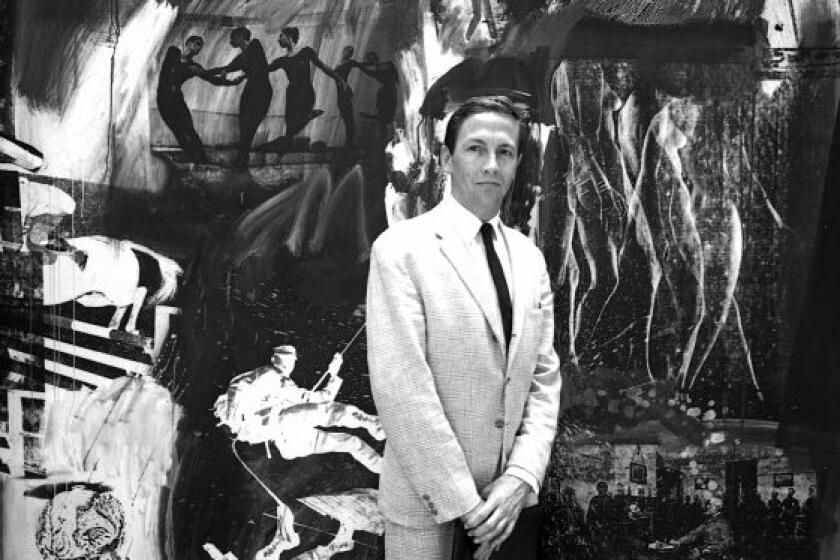Sharing Life’s Crosses : Artist deals with her childhood with two alcoholic parents in a work that invites participation.
There are crosses on the walls of the University of Judaism’s Platt Gallery. And images of angels. Not exactly what senior citizens attending an elder hostel summer program at the university expected to see when they wandered into the gallery.
These artworks, by Grace Gray-Adams and Vally Mestroni, members of the nonprofit artists’ organization Seeking It Through Exhibitions (SITE), are part of the exhibit, “In SITE--Out of SITE.” The show is one of five juried, members exhibits this year celebrating SITE’s fifth anniversary. The works of nine SITE members were selected by juror Stephen Nowlin, director of Art Center College of Design’s Williamson Gallery in Pasadena.
Gray-Adams’ “Project Parent: The People’s Cross” consists of two large crosses covered with small crosses. Viewers at previous shows were invited by the artist to write the names of loved ones lost as a result of alcohol or other drugs on the small crosses and attach them to the large ones.
They could also write their reactions and share their feelings in books provided in the installation. Those books are in this exhibit, along with a blank book for people to respond to this artwork.
Gray-Adams, an adult child of alcoholic parents, began this project in 1986 “when I decided to use my art-making as a means of uncovering the painful secrets of my childhood,” she writes in her artist’s statement. “I want to share my recovery with other children of alcoholics who still suffer, in the hope that I may help to ease their painful isolation. I use the cross not only as a symbol of death, but also as a metaphor for the action of processing pain.
“This is a process piece in which visitors are asked to participate. To show my respect to the University of Judaism, I have provided a basket of plain markers on which to write names. These markers may be nailed on the cross or on the memorial board.”
Judith Samuel, gallery coordinator, said the immediate reaction to Gray-Adams’ work by some elder hostel participants was one of shock. But then some of them attended the show’s opening reception, during which the artist spoke about the installation.
“They realized this work could apply to everyone,” Samuel said. “It became a real ecumenical experience, a learning experience.”
“The work did what SITE and the University of Judaism and art are supposed to do--be a catalyst, expand the dialogue. People had come together,” said Dean Andrews, a SITE board member involved in organizing the fifth anniversary shows.
The two oil and sheet metal on wood “Angels” of Mestroni’s diptych appear more as human than ethereal beings. Each is outlined with rivets. One angel wears a white dress; the other wears a red one.
Two of Mestroni’s four figures in her “Guardian of Peril” series hold airplanes. “In Judaism, we have a traveler’s prayer,” Samuel said. “Here we have an actual visual image of a protector of the traveler.”
While a third “guardian” cuddles the globe, another curiously holds a gun in her left hand, calling up several questions about the meaning of protection.
There is mystery to two untitled paintings by Mervyn Seldon from a body of work called “Absences and Presences.” In one image, a colorful two-piece bathing suit and a pair of sunglasses languish without a body. In the other painting, two figures are minus clothes except one of them sports a green hat.
Connie Mississippi considers male and female presence in her two-piece wood sculpture, “Sacred Sexuality.” Claire Browne-Del Mar confronts the dilemma of motherhood in “Eileithya,” named for the Greek goddess of childbirth. A box covered with bygone images of women encloses glass milk bottles hanging in nylon stockings. Rachelle Mark reflects upon the inner and outer forms of womankind in “Icon” and “Vessels of Her Soul.”
Gerald Gavzy, a former optometrist, gives us large visions of a microscopic inner world in his “Pathology Series” of oil paintings. Pam Posey’s expressive landscapes depict places from her memory and her imagination. Alexander Rudinsky captures the compelling light and color of two local vistas in his November landscapes.
Andrews said she sees this exhibition as “an opportunity to make SITE a little more visible and to expand our membership.” With a current roster of 250, membership is open to everyone. “We want to promote dialogue in the community and among artists.”
WHERE AND WHEN
What: “In SITE--Out of SITE.”
Location: Platt Gallery, 15600 Mulholland Drive, Bel-Air.
Hours: 10 a.m. to 4 p.m. Monday through Thursday, 10 a.m. to 2 p.m. Fridays, through July 9.
Call: (310) 476-9777, Ext 276. For information on SITE, call (213) 629-4532.
More to Read
The biggest entertainment stories
Get our big stories about Hollywood, film, television, music, arts, culture and more right in your inbox as soon as they publish.
You may occasionally receive promotional content from the Los Angeles Times.






